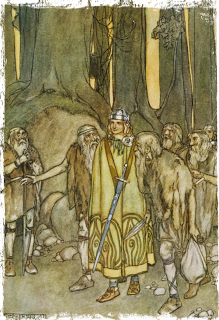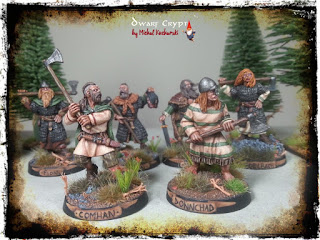
[ENG/PL] The story of Ná Fianna / Historia wojowników Fianna (Footsore Miniatures Irish Fianna with Axes)
The old-Irish atmosphere will probably be hosted on DwarfCrypt. The main reason for this is the beautiful miniatures I have the pleasure to paint and the extraordinary stories that I read about the Green Island in the early Middle Ages.
Today, the first two models of Fianna’s unit, and what was this strangely-sounding non-Irish warrior group you will find from the article below.
Figures come from FOOTSORE MINIATURES from their line of miniatures from the early medieval period of Ireland. I hope you like it!.
To help with this entry, I asked an Irishman, history and miniatures lover. What was Fianna? I invite you to journey with Ronan Duggan into the world of history, interspersed with myths, to the mighty and brave Ireland!
From the Dark Ages of tumultuous Irish History, before the Normans held dominion over much of the land, there existed on the Island of Ireland an order of warrior poets known as Ná Fianna, which roughly translates as „the wilderness/ wild ones“.
Historically, a fian was made up of a small group of young nobles, both men and women, perhaps all members of the same clan, who had not yet inherited property, and therefore existed outside of normal society. Collectively, these small groups were known as the Fianna. A warrior of the Fianna was called a fhéinní, and a female member of the Fianna was known as a banfhéinní. The number of banfhéinní likely diminished greatly with the rise of the Christian Church in Ireland. A Fianna leader would be recognised by the title Rifhéinní, which quite literally means „King of the Fianna„.
The Rífhéinní were in turn beholden to the High Kings of Ireland who would call on the skills of the Fianna in times of war and conflict. In Irish myth the greatest Fianna leader of them all was Fionn mac Cumhaill, a courageous hunter-warrior credited with superhuman feats of combat and daring. It remains a mystery if there was a real man behind the myth.
There is some debate by historians about how many individuals constituted a fian; some say the ideal number was 9, as 3, and multiples of 3, were considered a sacred number in early Irish culture. According to some sources, there were 27 (3×9), but the number could swell dramatically into an army of seven battalions, each one three thousand strong when the situation demanded it, such as in times of war or invasion.
In his 17th Century publication, the History of Ireland, Geoffrey Keating claims that in the winter, the Fianna were housed and provided for by the nobility, in return providing force of arms, but that during the summer months between the Irish seasons of Bealtaine and Samhain, they would live a nomadic life out in the wild, relying on hunting for food. In the Dark Ages of Irish history the land was covered in all manner of wild game and quarry, including wolves, wild boar and deer. The Fianna were expert hunters of these animals and likely wore their skins and adorned themselves with trophies.
Each individual Fianna warrior was skilled in the arts of war, being highly proficient with spear, axe and sword (although it seems throwing and thrusting spears were likely their main armament for centuries).
Also, in the early days of the Fianna, it is unlikely they wore any form of armour, preferring instead to be light and agile with light fabrics and animal skins. Joining the Fianna was not an easy task and Irish mythology speaks of very stringent entry requirements, which were not limited to martial skill.
Firstly, they had to be well educated, with the ability to recite and compose poetry (hence the warrior poet epitaph). In order to prove their physical capability, they were set many difficult tests of running, leaping and fighting. One example of a Fianna entry challenge involved the applicant young warrior being buried up to his or her knees with only a stick in hand for defence. Then he or she would be attacked by up to nine men wielding spears and if any wound was received the applicant would be denied entry to the ranks of the Fianna (likely because they were killed in the attempt).
Another entry challenge involved braiding the applicant’s hair and then setting him or her loose in the forest; with only a head-start as long as the breadth of a tree trunk. He or she would be chased by a group of warriors, and if capture was avoided without so much as a braid of hair being unravelled, he or she would accepted. Such accounts may be partly myth, but certainly martial prowess would have been a central feature of these ancient warriors.
According to ancient Irish myth, which was likely influenced by historical accounts, the Fianna lived by the following mantra, or code of honour:
“Truth in our hearts,
Strength in our arms,
Honesty in our speech.”
As the centuries passed and the Norsemen came and changed the face of Ireland, through conquest and integration, the nature and character of the Fianna changed and much was lost of the ancient traditions. It seems that the heyday of the Fianna was in the early Medieval period (5th to the 10th Centuries). That being said, the legendary Irish fighting force learned much from the Northern invaders and weapons and armour changed and the Fianna likely adapted to foreign battle techniques and learned to wield the large double handed Dane Axes that had proven so effective for the Vikings.
It seems likely that some remnant of the great warrior poet movement survived to the days of the last High King of Ireland, Brian Boru, and participated in the great Battle of Clontarf (1014), which saw a mainly native Irish Army, led by Boru, defeat a combined Norse-Gael/ Leinster force.
155 years later, the Normans, striking from Wales and Britain, invaded and began the long occupation of Ireland by foreign forces. For the most part, native Irish forces were crushed or driven west by the newcomers. It is likely that some remnant of the Fianna survived this onslaught and pursued guerrilla style tactics to harass the new occupiers, but as an effective fighting force they became all but extinct in the face of the heavily armoured and advanced Norman knights and their system of castle building. Ireland would never be the same and the Fianna would pass into myth and legend.*
*thanks Ronan for a great part of Fianna history!
Klimaty staro-irlandzkie zagoszczą chyba na stałe na DwarfCrypt. Główną tego przyczyną są piękne figurki, które mam przyjemność malować oraz niezwykłe historie, które czytam na temat Zielonej Wyspy w epoce wczesnego średniowiecza.
Dziś dwa pierwsze modele oddziału Fianna, a czym była ta dziwnie brzmiąca dla nie-Irlandczyków grupa wojowników dowiedziecie się z artykułu poniżej.
Figurki pochodzą od FOOTSORE MINIATURES z ich linii figurek z okresu wczesnośredniowiecznej Irlandii. Mam nadzieję, że Wam się spodobają.
Do pomocy przy dzisiejszym wpisie poprosiłem człowieka o irlandzkim sercu, miłośnika historii i figurek bitewnych. Czym byli Fianna? Zapraszam na podróż z Ronanem Dugganem w świat historii, przeplatanej z mitami, do walecznej Irlandii !
Od wczesnośredniowiecznej „ciemne wieki“, burzliwej historii Irlandii, zanim Normanowie opanowali większość ziem, istniała na zielonej wyspie specyficzna grupa poetów-wojowników znanych jako Ná Fianna, którą tłumaczy się jako „dzicz / dzicy“.
Historycznie, grupa ta składała się z młodych szlachciców, zarówno mężczyzn, jak i kobiet, być może wszystkich członków jednego klanu, którzy jeszcze nie odziedziczyli własności i istnieli przez to poza normalnym społeczeństwem.
Te małe grupy były powszechnie znane jako Fianna. Wojownik Fianna nazywał się fhéinní, a żeński członek Fianna był znany jako banfhéinní. Liczba banfhéinní prawdopodobnie zmniejszyła się znacznie wraz z wejściem chrześcijaństwa w Irlandii.
Przywódca Fianna otrzymywał tytuł rifhéinní, co dosłownie oznacza „Król Fianna“.
Rifhéinní byli z kolei pod opieką Wysokich Królów Irlandii, którzy w czasach wojny i konfliktu korzystali z umiejętności Fianna.
W irlandzkiej mitologii, największym przywódcą Fianna byl Fionn mac Cumhaill, odważny wojownik-myśliwy, któremu przypisywano nadludzkie czyny i wielką odwagę. Pozostaje tajemnicą, czy za mitem kryje się prawdziwy człowiek.
Niektórzy historycy debatują nad tym, ile osób składało się na Fianna; niektórzy twierdzą, że idealna liczba to 9, jako 3, a wielokrotności 3, były uważane za świętą liczbę we wczesnej kulturze irlandzkiej. Według niektórych źródeł było ich 27 (3 × 9), ale liczba ta mogła gwałtownie wzrosnąć do armii siedmiu batalionów, z których każdy składałby się z siły trzech tysiący, gdy wymagała tego sytuacja, na przykład w czasie wojny lub inwazji.
W swojej publikacji „History of Ireland“ Geoffrey Keating twierdzi, że zimą Fianna byli kwaterowani i utrzymywani przez szlachtę, w zamian za dostarczanie broni, ale w miesiącach letnich między Bealtaine i Samhain prowadzili koczowniczy tryb życia i polowali na wolności.
Każdy pojedynczy wojownik Fianna był wprawny w sztuce wojennej, posługiwał się biegle włócznią, toporem i mieczem (choć wydaje się, że rzucanie i pchnięcie włócznią było prawdopodobnie ich głównym uzbrojeniem przez stulecia). Również w pierwszym okresie istnienia Fianny jest mało prawdopodobne, aby nosili jakąkolwiek zbroję, preferując zamiast tego lekkość i zwinność ruchów.
Dołączenie do Fianna nie było łatwym zadaniem, a irlandzka mitologia mówi o bardzo surowych wymaganiach wstępnych, które nie ograniczały się tylko do umiejętności walki.
Po pierwsze musieli być dobrze wykształceni, potrafili recytować i tworzyć poezję (stąd poeta- wojownik). Aby udowodnić swoją fizyczną zdolność, postawiono im wiele trudnych prób- biegania, skakania i walki. Jednym z przykładów próby wejścia do Fianna było zakopanie młodego wojownika-kandydata po kolana z kijem w ręku w celu obrony.
Następnie zostaje on zaatakowany przez dziewięciu mężczyzn dzierżących włócznie, i jeśli zostanie draśnięty, zostaje pozbawiony wstępu w szeregi grupy (prawdopodobnie dlatego też, że zostanie śmiertelnie zabity podczas próby 😉 ).
Kolejne wyzwanie polegało na splataniu włosów kandydata, a następnie „rozluźnieniu ich“ na szerokość pnia drzewa do którego zostali przywiązani. Byli wówczas ścigany przez grupę wojowników i próbowali uniknięcia schwytania. Takie relacje mogły być częściowo mitem, ale na pewno walka była główną cechą tych starożytnych wojowników.
Według starożytnej irlandzkiej legendy, na którą prawdopodobnie miały wpływ historyczne relacje, Fianna żyła według następującej mantry, czyli kodu honorowego:
„Prawda w naszych sercach,
Siła w naszych ramionach,
Szczerość w naszej mowie. „
Wieki mijały, aż przybyli Normanowie i zmienili oblicze Irlandii. Zmieniła się natura i charakter Fianna, a wiele z ich starożytnych tradycji zostało utraconych i zapomnianych.
Wydaje się, że rozkwit Fianna można datować na wczesnym średniowieczu (od V do XI wieku). Mimo to legendarne irlandzkie siły bojowe wiele się nauczyły od północnych najeźdźców.
Broń i zbroja uległy zmianie, a i Fianna najprawdopodobniej nałożyła w końcu kolczugi i wzięła duże, dwuręczne duńskie topory, które okazały się wielce skuteczne na Wikingów.
Całkiem możliwe, że niektórzy członkowie wielkiego poetyckiego ruchu wojowników przetrwali do czasów ostatniego Wielkiego Króla Irlandii, Briana Boru, i wzięli udział w Wielkiej Bitwie pod Clontarf (1014). Więcej o tej epickiej bitwie W TYM MIEJSCU.
155 lat później Normanowie, uderzyli z Walii i Wielkiej Brytanii, najeżdżając i rozpoczynając długą okupację Irlandii.
W przeważającej części, rodzime siły irlandzkie zostały zmiażdżone lub przepędzone na zachód przez nowo przybyłych. Prawdopodobnie część Fianna przetrwała tę napaść, ale jako skuteczna siła bojowa wymarły całkowicie w obliczu ciężkozbrojnych i zaawansowanych rycerzy normańskich i ich systemu budowania zamków. Irlandia nigdy nie będzie już taka sama, a Fianna przejdzie do mitu i legendy.
1. The Battle of Clontarf / Cath Chluain Tarbh / Bitwa pod Clontarf || 2. The story of Murchad mac Briain / Historia Murchada, syna Briana Śmiałego
Dieser Artikel stammt von einer der angeschlossenen Quellen. Bitte honoriere die Arbeit der Autoren indem du ihren Webseite besuchst.
Artikelquelle besuchen
Autor: DwarfCryptDwarfCryptDwarfCrypt
Powered by WPeMatico

















